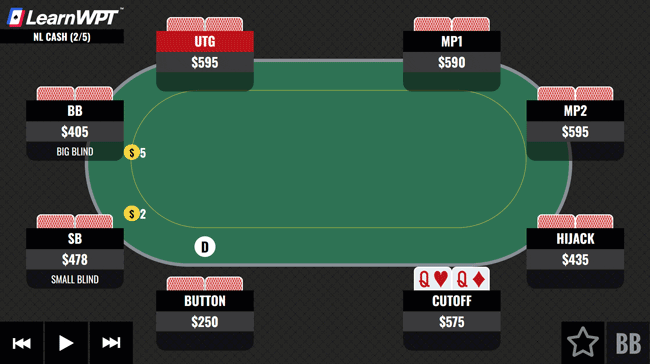Poker Quiz! Q♥Q♦ on a King High Board, What Do You Do Here?
DECISION POINT: In a loose eight-handed $2/$5 game the players in front of you limp and you raise to $40 from the Cutoff with Q♥Q♦. The Button calls, action folds to the MP1 limper who calls, and everyone else folds. The flop comes K♣J♠4♣, MP1 checks, and action is on you.
What do you do here?
PRO ANSWER: We are playing in a loose $2/$5 game where most players have $500 stacks. We are dealt QhQd in the Cutoff seat and the first 3 players in front of us limp in. With a premium hand we are definitely going to raise, the main question is “how much?”.
Usually we raise a standard amount preflop for that table plus add one Big Blind for each limper to the call amount, in this case $15 + $20 for the calls. In looser games sometimes we want to make it larger because often if we get one caller it sets off a cascading effect that encourages multiple callers and suddenly we’re playing a hand multi-way that is preferred to play heads up. In this spot we decide to make it $40 and the Button cold calls, MP1 calls, and everyone else folds.
The flop is KcJs4c and MP1 checks. This is a tricky spot because against the shorter stack on the Button the stack to pot ratio (SPR) is less than 2, but against MP1 it’s closer to 4. This makes it very tough for us to ever fold our hand vs the Button but in the right circumstances we could get away from our hand against MP1. There is a flush draw and multiple straight draws on the board however we block the straight draws having two queens in our hand.
It is crucial to determine if the benefit of protecting our hand against potential flushes outweighs the option of keeping our opponent’s ranges wide so we could potentially get to showdown profitably against a hand like Jx or TT, or induce some future bluffs.
Continued below ...
We also have to consider that when we bet here most of the hands we beat that are draws will fold, while all the hands that beat us will likely continue. Since the draws are unlikely to fold we aren’t really “protecting” our hand very much.
By betting we are potentially building value against hands that have good equity against us already, while at the same time setting ourselves up to lose a bigger pot against Kx hands or sets that we are drawing extremely thin against.
Checking here allows us to keep our opponent’s ranges wide, induce bluffs, and gives us a pretty clear game plan. If the Button bets and MP1 folds we’re pretty content to just get the rest of the money in passively against the shorter stack. If the Button bets and MP1 continues our next move will depend on the size of the bet. If action checks through and MP1 bets the turn we will continue on most turn cards and then reevaluate on the river.
While these spots can be tricky to play, multi-way pots often favor equity realization and controlled showdowns over hand protection. We are unlikely to generate folds from significant draws with large sizing and when behind we lose a much bigger pot than we need to.
Checking is the best play.
How would you play it?
Share your answer in the comments below!
Improve Your Game Today!
Join LearnWPT and Get:
- The WPT GTO Trainer to play real solved hands and get instant feedback on YOUR leaks (over 4 BILLION solved spots!)
- On-demand access to our full library of 500+ (and growing) in-depth Strategy Episodes from world-class players
- All of your poker questions answered with the Ask a Pro Feature
- Expert analysis from LearnWPT Pros using The Hand Input Tool
- Downloadable Tools you can use at and away from the tables
- Learn from a Team of world-class Professional Players
To join (just $5 your 1st month) click the JOIN NOW button and start improving your game!
Have Questions about LearnWPT? Email us at [email protected].

